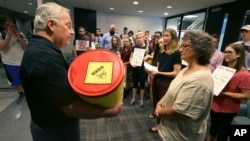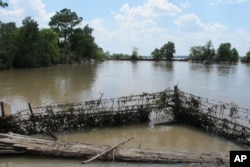The Trump administration handed a rare victory to environmentalists, ordering two big corporations this week to pay $115 million to clean up a Texas toxic waste site that may have spread dangerous levels of pollution during flooding from Hurricane Harvey.
Environmental Protection Agency Administrator Scott Pruitt signed a directive Wednesday requiring International Paper and McGinnis Industrial Maintenance Corp., a subsidiary of Waste Management Inc., to excavate 212,000 cubic yards of contaminated sediments from the San Jacinto River Waste Pits site.
Pruitt visited the Superfund site outside Houston last month following historic rains and flooding from the storm, meeting with local environmental activists who had campaigned for years for approval of a cleanup plan.
Cleaning Superfund sites a top priority
Pruitt has said cleaning Superfund sites is among his top priorities, even as he has worked to delay and rollback a wide array of environmental regulations that would reduce air and water pollution. Often Pruitt has done so directly at the behest of industries that petitioned him for relief from what they characterize as overly burdensome and costly regulations.
At the San Jacinto Pits, both companies opposed the expensive cleanup, arguing that a fabric and stone cap covering the 16-acre site was sufficient. The former site of a demolished paper mill that operated in the 1960s, the island in the middle of the San Jacinto River is heavily contaminated with dioxins — chemicals linked to cancer and birth defects.
“International Paper respectfully disagrees with the decision by the EPA,” said Tom Ryan, a spokesman for International Paper. He said removing the existing protective cap “could result in significant damage to public health and the local environment.”
'Yellow journalism'
The Associated Press reported Sept. 2 about the risks from flooding at Houston-area Superfund sites, highlighting six prior occasions where the cap at the San Jacinto Waste Pits required significant repairs. Journalists surveyed seven flooded Superfund sites in and around Houston by boat, vehicle and on foot, including San Jacinto.
EPA said at the time it was too unsafe for its personnel to visit the sites, and accused the AP in a statement of engaging in “yellow journalism” and creating panic. Nearly one month later, however, the agency confirmed that contaminated sediments at San Jacinto had, in fact, been uncovered by the storm.
A sample collected by an agency dive team from an exposed area at the site showed dioxin levels at 70,000 nanograms per kilogram — more than 2,300 times the level set to trigger a cleanup. Dioxins do not dissolve easily in water but can be carried away with any contaminated sediments and deposited over a wider area.
EPA said two weeks ago that additional testing will now be needed to determine whether the contamination spread and to ensure that the exposed waste material is isolated. EPA did not respond to requests for comment Thursday about whether that assessment was complete or what results were.
Galveston Bay a concern
The San Jacinto River empties into Galveston Bay, where state health officials have long advised against regularly consuming fish and shellfish due to contamination from dioxins and PCBs. The cleanup plan EPA approved this week requires the construction of a temporary dam to hold back the river while workers use heavy machinery to dig up and remove enough contaminated soil and sentiment to fill more than 16,000 dump truck loads.
One of the local environmental advocates who met with Pruitt during his visit last month, Jackie Young, said people living along the river south of the waste pits still don’t know whether the floodwaters carried toxins to their yards and homes.
“This is a monumental victory and testament to what an engaged community can accomplish,” said Young, executive director of Texas Health and Environment Alliance. “We may never know the extent of damage from Hurricane Harvey or numerous other storms, but at least the EPA is putting their best foot forward and moving in the only direction that upholds their mission.”










